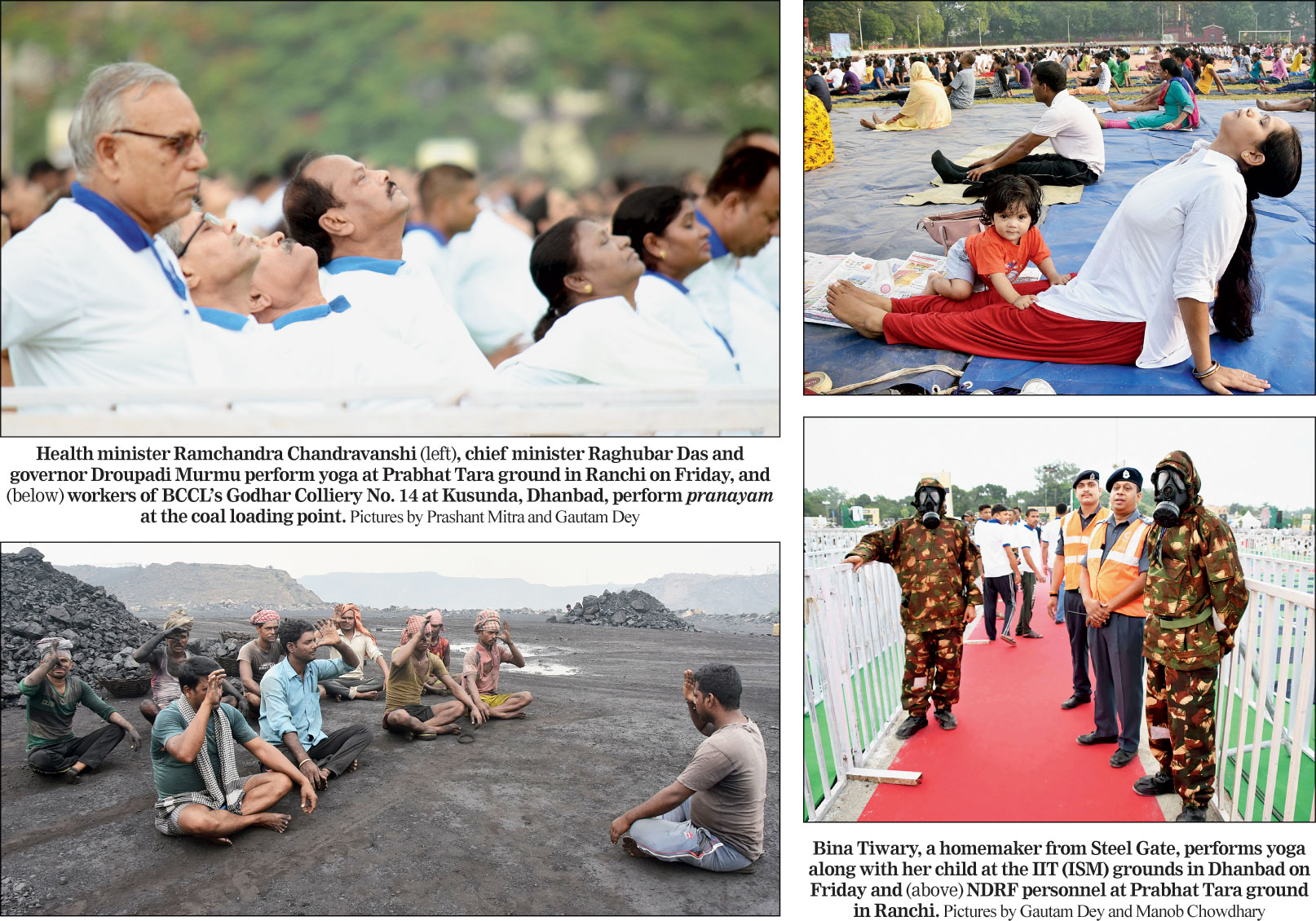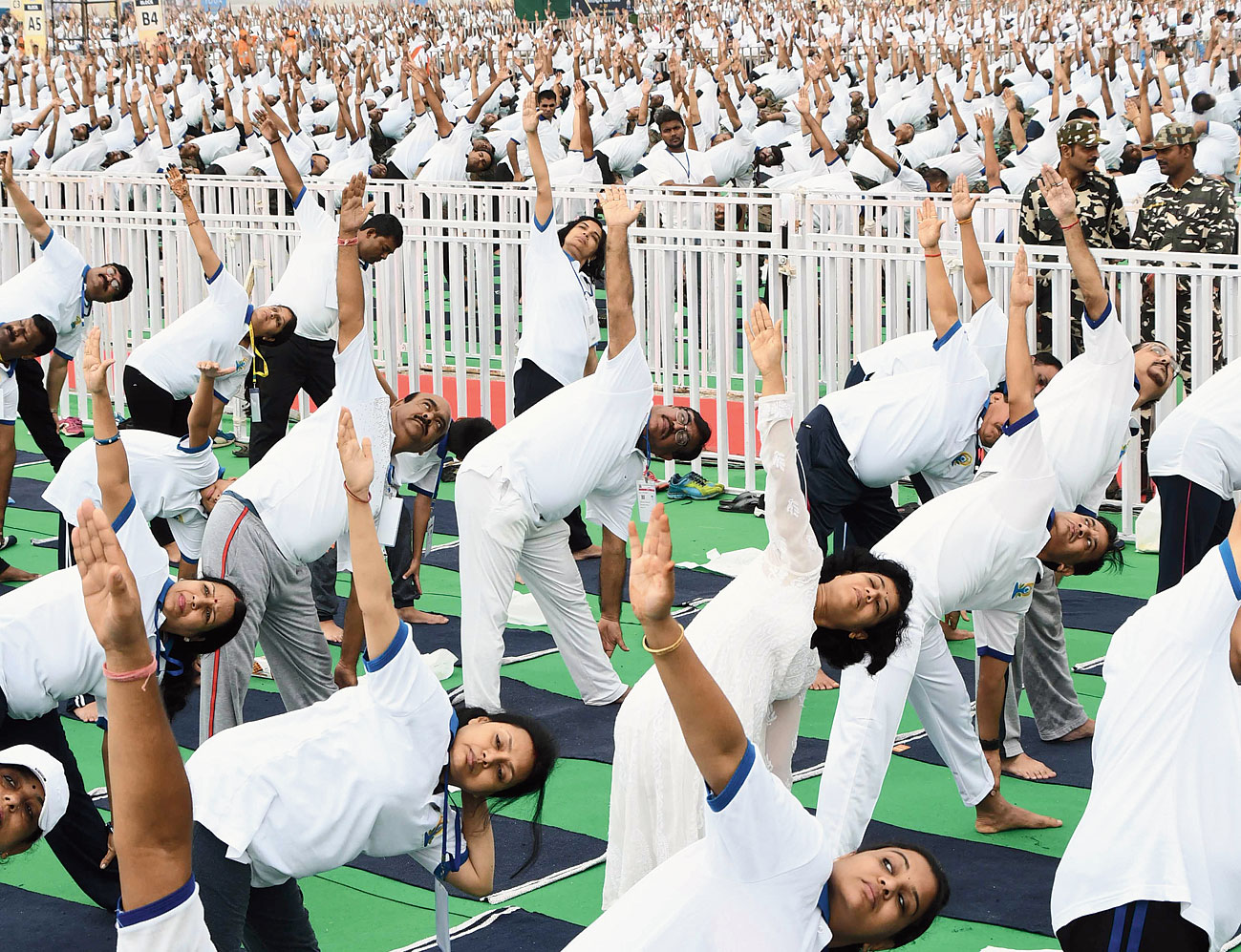Sanjeev Kumar Verma of The Telegraph speaks to Patna-based yoga expert Dharm Vijay, who spent over a dozen years at the Bihar School of Yoga, about the benefits of some of the asanas Prime Minister Narendra Modi did on Friday at the International Yoga Day event at the Prabhat Tara ground in the capital.
Greeva Sanchalana (neck movements)
Nerves connecting the different organs and limbs of the body pass through the neck and hence the muscles of the neck and shoulders accumulate stress during work. Neck movements release tension, and stiffness of neck and shoulder. One needs to be particular about the breathing while doing this asana, and hence learn it from an expert. Elderly persons with low or high blood pressure or those suffering from spondylosis should seek advice from experts before doing this asana. Cervical spondylosis patients should avoid forward bending of the neck.
Skandha Chakra (shoulder rotation)
This helps in making the bones, muscles and nerves of the neck and shoulder healthy. It also helps patients with cervical spondylosis and frozen shoulder.
Vajrasana (thunderbolt pose)
It alleviates menstrual disorders, increases the efficiency of the digestive system. People suffering from piles and those having knee pain and ankle injury should not practise this asana.
Trikonasana (triangle pose)
It makes the spine flexible, strengthens the calf, thigh, and waist muscles and improves lung capacity. People with slipped disc and sciatica should avoid doing this asana.
Makarasana (crocodile pose)
It helps in relaxation of the whole body and also helps in back problems. Pregnant women and people with frozen shoulder should avoid this posture.
Bhujangasana (cobra pose)
It relieves stress and reduces abdominal fat. It also relieves constipation. Those having undergone abdominal surgery should avoid this for up to two to three months after surgery. Those suffering from hernia and ulcers should not practise this asana.
Setubandhasana (bridge pose)
It relieves depression, anxiety and strengthens lower-back muscles. It also improves digestion and helps relieve constipation. People suffering from hernia or ulcers should not practice this asana.
Pawanmuktasana (Wind releasing posture)
Removes constipation and gives relief from flatulence. It tones up the back muscles and spinal nerves. People with abdominal injury, hernia and sciatica should avoid this posture.


Prime Minister Narendra Modi performs the Uttana Padasana, which helps in relieving abdominal pain, indigestion, and depression, along with other yoga day participants at Prabhat Tara ground in Ranchi on Friday. (Pictures by Prashant Mitra and Manob Chowdhary)
Ardha Ustrasana (half camel pose)
It helps in strengthening back and neck muscles and relieves constipation and back pain. It increases blood flow to the head and cardiac region. In case of hernia, abdominal injuries, arthritis and vertigo, people should avoid doing this asana.
Kati Chakrasana (waist rotation)
This asana tones the neck, shoulders, waist, back and hips. It is useful for correcting stiffness of the back, and postural problems.
Ustrasana (camel pose)
It is helpful in relieving back and neck pain and also useful for defective eyesight. It helps in reducing fat in the and abdomen and hips. Those suffering from heart disease and hernia should not practise it.
Sasakasana (hare pose)
Helps reduce stress and anxiety and tones up reproductive organs. It also helps in relieving back pain and improves digestion. Those with acute backache should avoid this.
Uttana Mandukasana (stretched frog pose)
This helps in cervical spondylosis and reduces back and neck pain. It also increases lung capacity. People with severe knee pain should not perform it.










